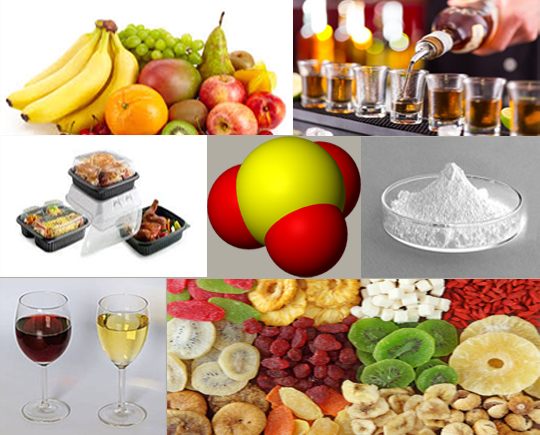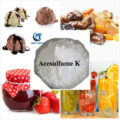Sulfites are substances that are naturally found in some foods. They are used as an additive to maintain food color, and shelf-life and prevent the growth of fungi or bacteria. Sulfites are also used in food packaging like cellophane.
Sulfur dioxides and sulfites (E220 – E228) are chemical compounds that can be naturally occurring (sulfur dioxide is present in wine or beer, for example) and are most commonly used as preservatives in a wide range of foods. They are used to extend the shelf life of products, as well as to kill bacteria, and are popular due to their ability to maintain product color and have a softening effect – particularly useful in the dried fruit market.
Dried fruits and vegetables routinely report the highest levels of sulfites, due to their preservative abilities, while maintaining color and texture. This makes them especially popular in lighter-colored fruits and vegetables that risk turning brown. Sulfite sensitivity is an abnormal reaction to these compounds.
What are the symptoms of sulfite sensitivity?
Symptoms of sulfite sensitivity can vary from person to person and can range from mild to severe. These include:
- Itching or urticaria
- Swelling or angioedema
- Dermatitis
- Eczema
- Flushing
- Low blood pressure
- Abdominal pain
- Diarrhea
- Asthmatic reactions
- Occasionally, severe anaphylactic reactions
How many sulfites does it take to cause a reaction?
Unlike IgE-mediated allergies, sulfite sensitivity appears to be dose and individual dependant, meaning the more you consume, the more severe the reaction is. Sulfite concentrations vary from product to product and will depend on how much of that product you eat, so it is tough to fully understand how much it takes to produce a reaction. For example, you may be able to eat a teaspoon of Dijon mustard with no symptoms, but you wouldn’t be able to drink a glass of wine.
How to Identify Hidden Sulphite In Foods
Despite safety concerns, products that contain sulfites do not always have clear labeling. According to the FDA, products that contain a sulfite should include a warning statement as part of their labeling, stating that the product contains a sulfite that “may cause allergic-type reactions including anaphylactic symptoms and life-threatening or less severe asthmatic episodes in certain susceptible people.
Labeling sulfites can be tricky and that’s why it has become an issue of late. “Drugs that are labeled as preservative-free can still contain sulfites. They might say that they are not used as preservatives; they are used as antioxidants. Or there could be trace amounts of sulfites that are residuals from the manufacturing of the drug
Public health experts insist sulfites MUST be labeled when they occur in foods over 10 ppm (parts per million). Sulfites are labeled in the ingredient list, or in a ‘contains’ or ‘may contain’ statement on the package and will vary from product to product, but in Canada and the US are typically labeled:
- Potassium or sodium bisulfite
- Potassium or sodium metabisulphite
- Sodium sulfite
- Sodium dithionite
- Sulfurous acid
- Sulfur dioxide
Watch the Video below
How is Sulfite Sensitivity Diagnosed
A doctor who treats allergies can diagnose sulfite sensitivity with a food challenge. This means giving the person a small number of sulfites and watching for a reaction. If the person does not have a reaction, the amount they are given will slowly be increased. If the person does have a reaction, medicine will be given to treat it. Tests will also be done to check lung function. A food challenge should only be done by a doctor who treats allergies.
How to Avoid Sulfites
A person who is sensitive to sulfates should do their best to try to avoid them. This can be hard since they are common in many foods and come in lots of forms.
Here are some ways to live sulfite-free.
What to Look For
Many products contain sulfites, so be sure to check the food label. They can be found in:
- Beer, wine, and soft drinks
- Cookies, crackers, pie crust, and pizza crust
- Dried fruit
- Shrimp, lobster, and scallops
- French fries and other food made with peeled potatoes, such as instant mashed potatoes
- Fruit or veggie juice
- Canned fruits or veggies
- Syrup and fruit toppings
- Pickles, relish, olives, and salad dressing
- Noodle or rice mixes, dried soup mixes
Food made from bulk items would have the sulfites listed on the package. One example is bread bought at a bakery. The store should list sulfites on the bread label. A person who has any questions should ask the staff about it. The same approach can be used when dining out by asking the waiter or chef.
Sulfite-Free Choices
Sulfite is a common preservative. It can be hard to fill a kitchen with sulfite-free products. But there are choices, like specialty grocery stores and websites that sell health foods.
Sulfites in Medicine
Sulfites are added to many prescription and over-the-counter medicines. It is often found in drugs used to treat asthma and allergies. Be sure to read drug labels. A doctor and pharmacist can help answer any questions.
Be Prepared
A person with sulfite sensitivity should talk to their doctor about whether they need to carry emergency medicine. A medic alert bracelet can also be worn to let others know that the person has a food allergy. READ: Sulphur: The Hidden Acesulfame K (E950) Danger






